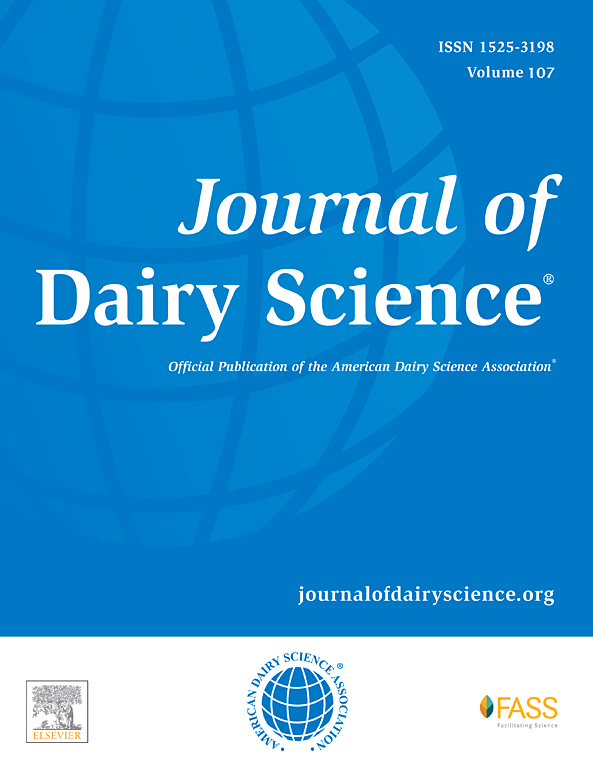产后早期发情特征:揭示其对奶牛生育能力的预测潜力。
摘要
本研究旨在探讨安装了自动监测装置(AMD)的奶牛产后早期发情特征(EPEC)与生殖结局的关系。我们假设41个DIM内的EPEC反映了奶牛的生理弹性,并可作为后续生育的预测因子。此外,我们训练并测试了预测奶牛生育潜力的算法,并比较了低、中、高生育能力奶牛的繁殖性能。这项研究使用了来自3个商业奶牛群的4578头荷斯坦奶牛的数据。收集产犊特征、产后健康、产奶量、EPEC(发情事件、持续时间、反刍最低点、活动峰值和热指数)和环境数据。生殖结局包括首次服务后怀孕77±14 d,生育等级(高生育力[HFERT] =首次服务后怀孕,低生育力[LFERT] =前3次服务后未怀孕)和怀孕危险高达250 DIM。使用训练数据集,我们开发了一种算法,该算法应用于训练和测试数据集,将奶牛分为低、中等和高生育力;然后比较这些奶牛的繁殖性能。统计分析包括logistic回归和Cox比例风险回归。总体而言,38%的奶牛在第一次服务后77±14 d怀孕,到第三次服务时累计怀孕率为67%。在41 DIM内至少有1次发情事件的奶牛妊娠至第一次服务的几率较大(0 = referent, 1 = 1.20 [95% CI = 1.01-1.44],≥2 = 1.16 [95% CI = 0.89-1.52]),且母牛为HFERT (0 = referent, 1 = 1.26 [95% CI = 1.00-1.59],≥2 = 1.09 [95% CI = 0.78-1.54])。然而,超过1次发情事件并没有进一步改善生育结果。41 DIM内发情与妊娠危险呈正相关,表现在较短的开放天数(0 = 115.0 d, 1 = 94.0 d,≥2 = 89.0 d)。较低的反刍最低点与怀孕至第一次服务的几率增加以及奶牛被HFERT的几率增加有关。同样,处于反刍最低点最低分位数的奶牛在250 DIM时怀孕的风险最大。在测试数据集中,被分类为生育能力最低和最高25%百分位数的奶牛在平均开放天数(127 d对104 d)方面有23个百分点的差异,在250 DIM时的审查中有5.3个百分点的差异(28.6%对23.3%)。本研究表明,EPEC是奶牛生殖潜能的重要指标。将健康、遗传和环境数据与EPEC相结合可以改善对生育结果的预测,为优化奶牛群的生殖管理和效率提供机会。最后,我们的算法结果证明了EPEC预测泌乳荷斯坦奶牛长期繁殖性能的潜力。This study aimed to investigate the associations among early postpartum estrous characteristics (EPEC) and reproductive outcomes in dairy cows fitted with automated monitoring devices (AMD). We hypothesized that EPEC within 41 DIM reflects cows' physiological resilience and serve as predictors of subsequent fertility. Furthermore, we trained and tested algorithms predicting the fertility potential of cows and compared the reproductive performance of cows classified as low, moderate, and high fertility. The study was conducted using data from 4,578 Holstein cows across 3 commercial dairy herds. Data regarding calving characteristics, postpartum health, milk yield, EPEC (estrus events, duration, rumination nadir, activity peak, and heat index), and the environment were collected. Reproductive outcomes of interest included pregnancy 77 ± 14 d after the first service, fertility class (high-fertility [HFERT] = pregnant to first service; low-fertility [LFERT] = nonpregnant after the first 3 services), and hazard of pregnancy up to 250 DIM. Using a training dataset, we developed an algorithm that was applied to the training and testing datasets to classify cows into bottom, moderate, and top fertility; the reproductive performance of these cows was then compared. Statistical analyses included logistic regression and Cox proportional hazard regression. Overall, 38% of cows were pregnant 77 ± 14 d after first service, with a cumulative pregnancy of 67% by the third service. Cows with at least 1 estrus event within 41 DIM had greater odds of pregnancy to the first service (0 = referent, 1 = 1.20 [95% CI = 1.01-1.44], ≥2 = 1.16 [95% CI = 0.89-1.52]) and of a cow being HFERT (0 = referent, 1 = 1.26 [95% CI = 1.00-1.59], ≥2 = 1.09 [95% CI = 0.78-1.54]). However, more than 1 estrus event did not further improve fertility outcomes. The positive association between estrus within 41 DIM and hazard of pregnancy was reflected in shorter days open (0 = 115.0 d, 1 = 94.0 d, ≥2 = 89.0 d). Lower rumination nadir was associated with increased odds of pregnancy to the first service and of a cow being HFERT. Similarly, cows in the lowest tertile of rumination nadir had the greatest hazard of pregnancy by 250 DIM. Cows in the testing dataset classified as bottom and top 25% percentiles of fertility had a 23-d difference in median days open (127 d vs. 104 d) and a 5.3-percentage point difference in censoring by 250 DIM (28.6% vs. 23.3%). This study demonstrates that EPEC are valuable indicators of reproductive potential in dairy cows. Integrating health, genetic, and environmental data with EPEC improves the prediction of fertility outcomes, providing opportunities to optimize reproductive management and efficiency in dairy herds. Finally, the results of our algorithms demonstrate the potential of EPEC to predict long-term reproductive performance of lactating Holstein cows.

 求助内容:
求助内容: 应助结果提醒方式:
应助结果提醒方式:


